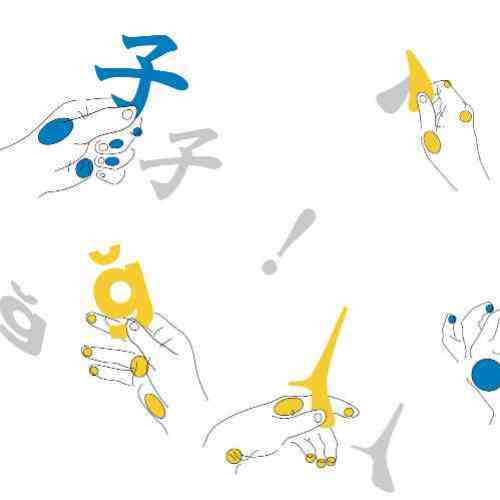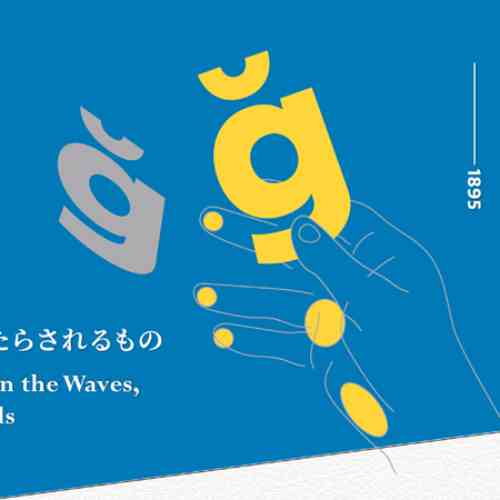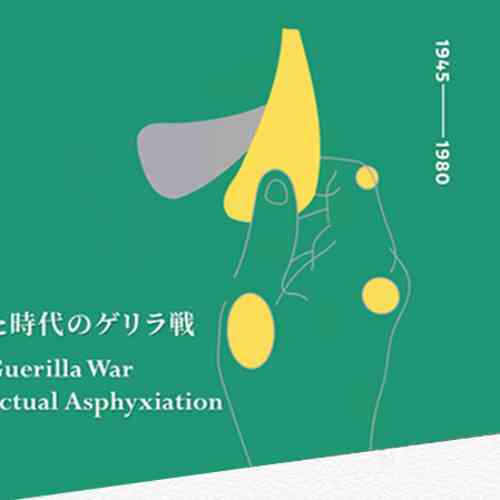.jpg)
༼ •̀ ں •́ ༽ Straddling East Asia's Cultural Fault Lines: The Dawn of 'New Literature'
Absorption into the Empire of Japan created an identity crisis for the island's classically educated elite. Nearly 300 poetry societies were established island-wide during this time to preserve and nurture Chinese literary forms, with the Li Society, Ying Society, and Southern Poetry Society among the most successful. While colonial rule brought repression, it also introduced a modern public education system. After earning advanced degrees in Japan and China during the 1920s, the first generation of 'new intellectuals' returned home to sow the seeds of Taiwan's New Literature (Shin Bungaku) movement.
New and old literary traditions cross-pollinated and competed to create a vibrant new literary landscape. THE TAIWAN MINPAO rose to the fore as the flagship publication of Taiwan's 'new media', helping fan the flames of a running tussle, led by Chang Wo-chun, Zheng Kun-wu, and others, between 'new' and 'old' schools of literature. However, the lines in this literary 'conflict' were indistinct. The old school remained dominant, although new literature was gaining steadily. Writers, including Lai Ho, Yang Yun-ping (Lûⁿ Hûn-phêng), and Yang Shou-yu, emerged at this time who were both adept at writing classical Chinese poetry and prose and also eager to try their hand at writing novels and new-form poetry. 'Synthesis' is the hallmark of this period in Taiwanese literary history. Although a cursory examination may define it as standard Chinese, Taiwanese synthesis literature of the early 20th century is unique in weaving Japanese and Hokkien languages onto a single literary frame.
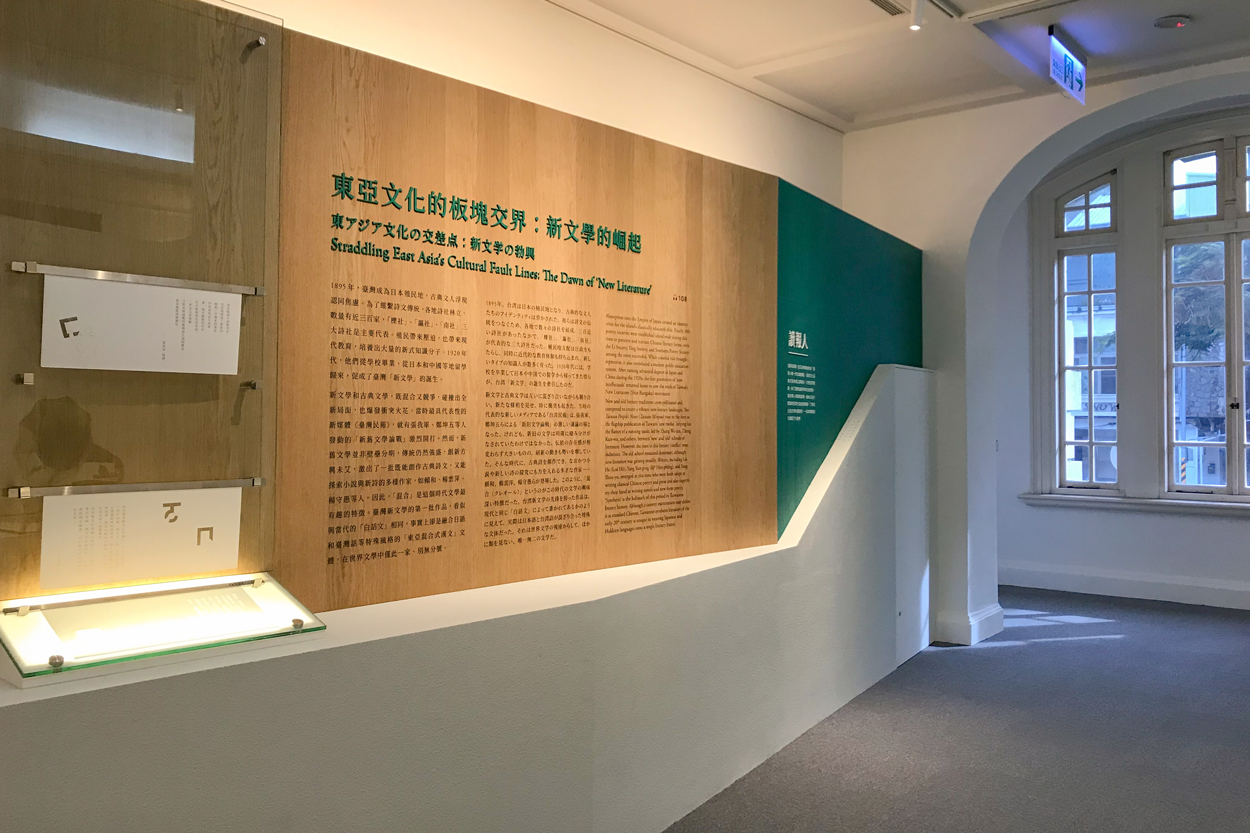
The 1930 publication of "Why is Nativist Literature Not Being Promoted?" by Huang Shih-hui (N̂g Se̍k-hui) sparked widespread discussion and set the stage for the first island-wide battle over the essence of nativist literature.
Nativist literature refers to literature written in the Taiwanese dialect (Hokkien). The main focus of controversy was the desirability of developing literature written in Hokkien. What language should be used to reach the largest audience? However, different perspectives on cultural identity among contemporary Taiwanese writers led to differences in how each defined his or her target audience. Liao Yu-wen and other authors sidelined Hokkien in favor of standard Chinese to reach the largest Chinese audience, while others, including Huang Shih-hui, wrote in Hokkien to, 'convey fully Taiwan's distinct culture and scenery.'
Growing numbers of Taiwanese authors flocked to the nativist Hokkien camp, with VOICE OF THE SOUTH PERIODICAL, published by Guo Qiu-sen (Koeh Chhiu-seng / Kaku Shūsei), serving as the movement's flagship publication. Nativist literary trends continued to grow until the outbreak of the Sino-Japanese War in 1937, when the colonial government banned all Chinese-language publications.
.png)
THE TAIWAN MINPAO was regarded as "the only channel for Taiwanese people to express their opinions" during the Japanese Colonial Period. The Taiwan Culture Association established newspaper reading clubs for the general public. In a society with widespread illiteracy, there were people responsible for summarizing and reading newspapers so that illiterate people could also understand the importance of democracy and literature through listening to newspapers. Let's listen to some of the articles that were printed in the first issue!
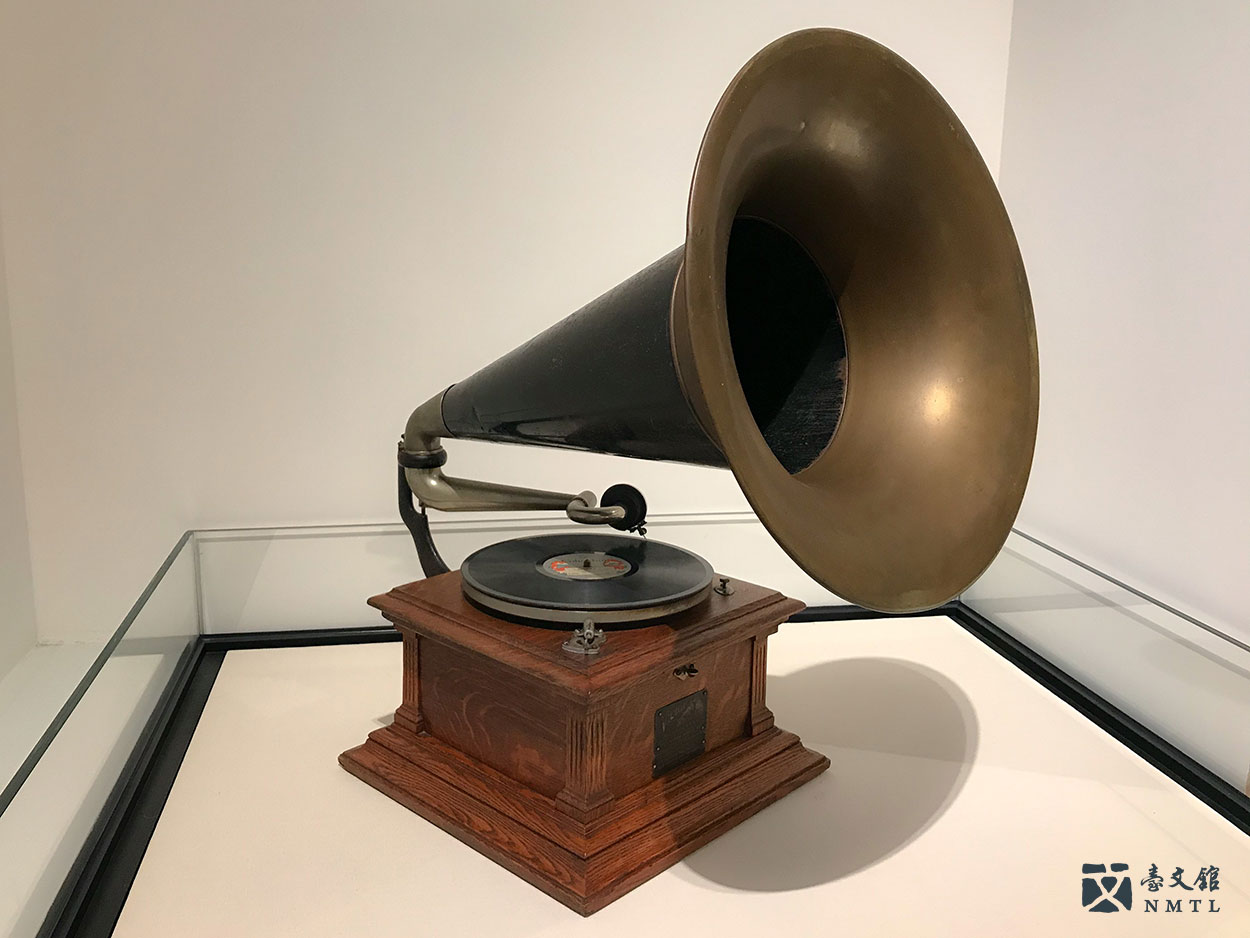
▸ Phonograph Victory No.3|ca. 1910s. Phonograph Victory No.3 is a classic hand-cranked phonograph. After Japan took over Taiwan, phonographs and records were rapidly introduced to Taiwan. The beautiful sounds became a powerful tool for cultural dissemination. Phonograph Victory No.3 has a copper-bottomed loudspeaker with an elegant shape and a round, pure sound quality, which made it a popular phonograph during the Japanese Colonial Period.

▸ Lai Ho's Chinese Poetry Manuscript|Written by Lai Ho. This is a 76-page handbound book. The poems in this book are currently not included in Images of Lai Ho's Manuscripts. However, the poems are the same as those in the 7th volume of "Chinese Poems" in Lai Ho's Poetry Collection. The Collection was clearly based on this edition. The word "芸" ("art" in simplified Chinese) in this manuscript is all mistakenly written as "藝 ("art" in Traditional Chinese) in Lai Ho's Poetry Collection. Some pages are missing and there are also differences between this manuscript and Lai Ho's Poetry Collection.
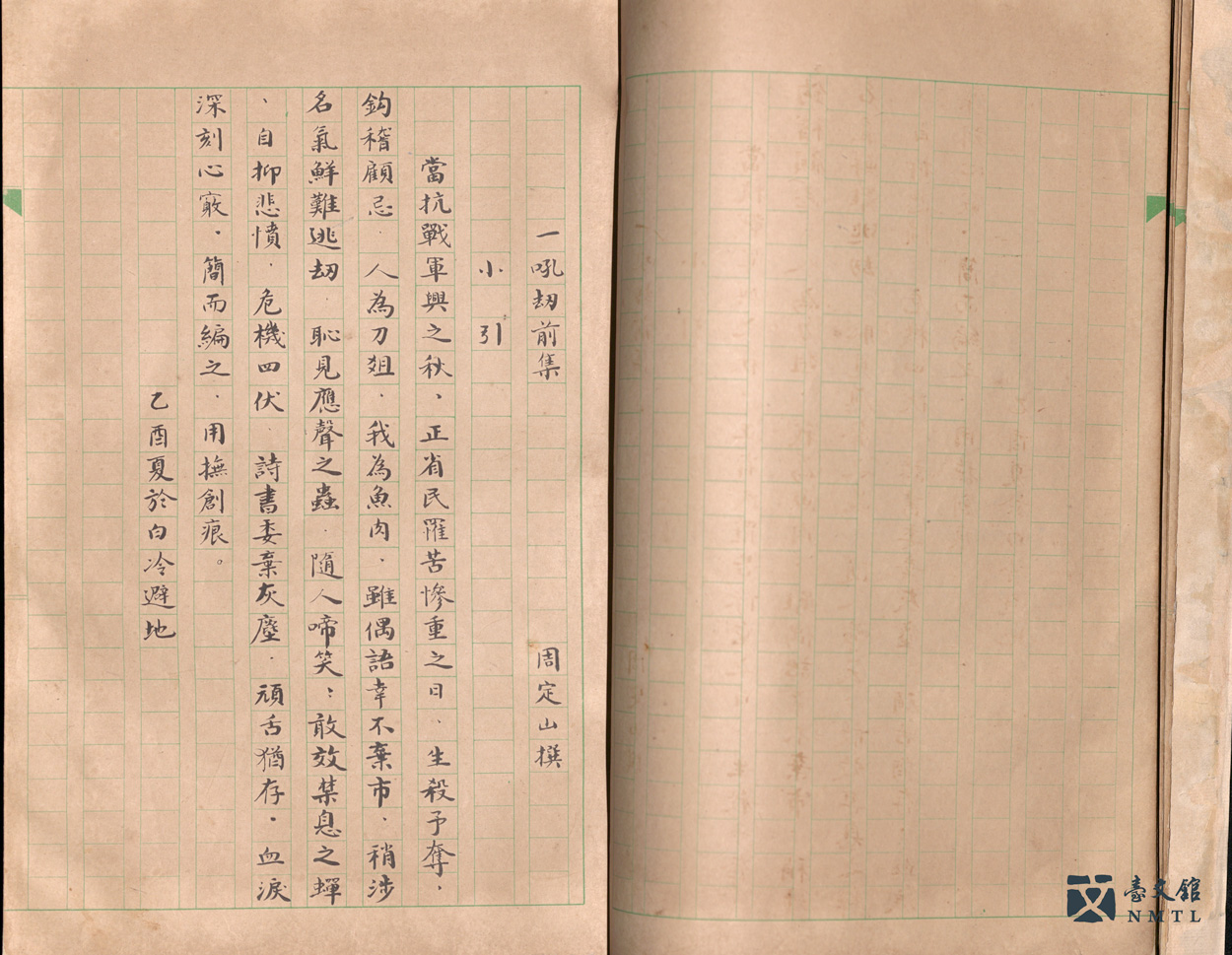
▸ Zhou Ding-shan, YIHOU BEFORE TIME VOL.1 Poetry Manuscript|Zhou Ding-shan (1898-1975), aka Ke Ya or Yi Hou. Born in Lugang in Changhua County, Zhou was an important literary figure in his hometown during the Japanese Colonial Period. Divided into three books, the manuscript was completed in 1975. It is a collection of the best of Zhou's poems. The "time" here refers to the year 1945.
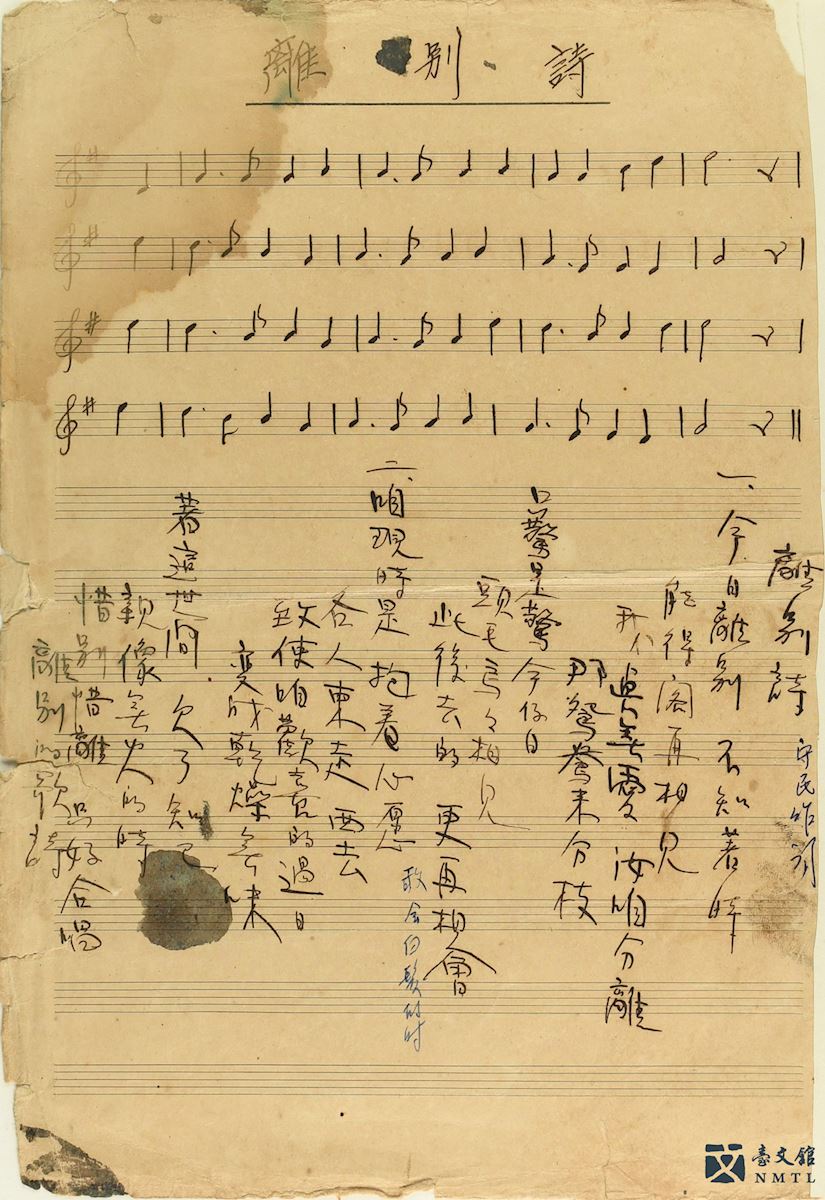
▸ "Poem of Parting" Music Score|Lyrics by Lu Bing-ding and Sung by Lim Si-ho. In the late 1920s, Lu increasingly participated in labor movements and movements against Japanese colonization. To ensure the safety of his family, he bade farewell to his wife Lim Si-ho, striking out alone on his path of social activism. This song's melody, while not sad, is filled with the sorrow of parting.
ლ( ⁍ื ᆺ ⁍ื )ლ We Came by Train: Colonial Modernity
While the colonial economy was kept in line by authoritarian force, colonial authorities used education, economic incentives, and other levers to promote social change under the framework of 'colonial modernity.'
Against this backdrop, colonial-era literature began incorporating a myriad of modern elements. While raising industrial productivity and introducing many new conveniences, modernization also led to chronic unemployment and the erosion of traditional culture. Colonial modernity challenged nearly every aspect of life. Trains, for example, were greeted by Taiwanese with a complicated admixture of astonishment, fright, and curiosity. The completion of the West Coast railway in 1908 sealed Taiwan's accession into a new era of commerce and industry. Concepts of 'late' and 'on time' entered the public conscience.
The gradual connection of much of the island by rail reinforced and expanded the Taiwanese identity. Contemporary literature drew on and underlined these transformative shifts.
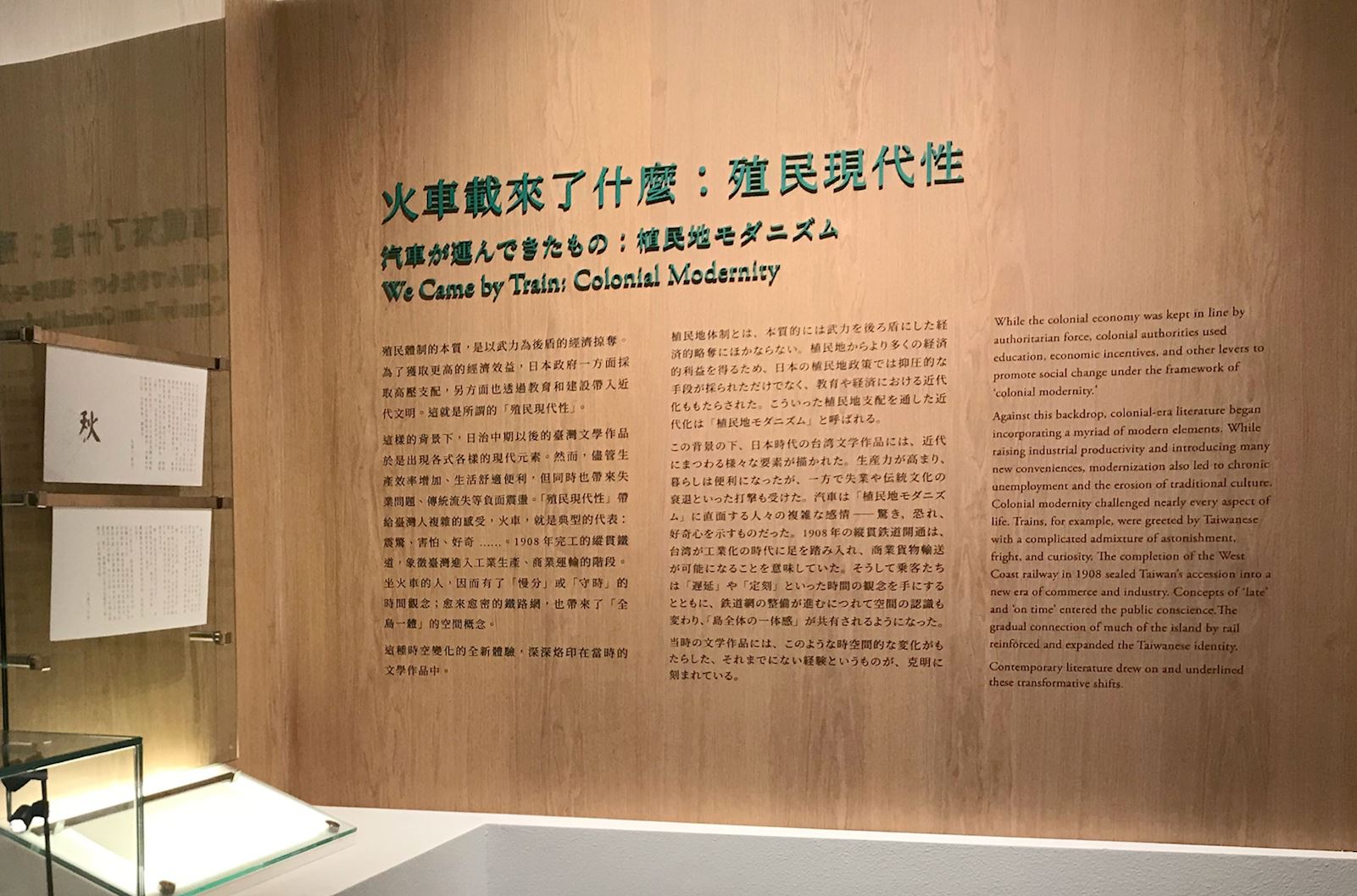
In addition to novels, classical and new poetry written during the late Japanese Colonial Period employed. Innovative meter and rhythms to reflect the gradual acclimation of writers to modern mores.
Factories, airplanes, telephones, and movies were the obvious symbols of the transition from 'old' to 'new'. However, this transition ran much deeper -- reconfiguring public education, fostering urbanization, and promoting broadcast media and public entertainment. These developments fundamentally changed social constructs and gradually introduced concepts of liberty, equality, and human rights into the social milieu. Taiwan's curated cultural 'enlightenment' had brought Taiwanese society into step with the world, inspiring new dreams and ambitions in the process.
Dreams and nightmares. Hopes and frustrations … All are important threads defining the literature of colonial Taiwan.
封面NMTL20060700002-001.jpg)
內頁(目錄頁)NMTL20060700002-002.jpg)
▸ PINWHEEL POEM PERIODICAL (Vol.3) Cover & Inside Pages (table of contents)|Pinwheel Poem Periodical was a magazine published by "Pinwheel Poetry Society," which was founded in 1933. There were in total 4 issues released. With Yang Chi-chang (aka Shui Yin Ping) acting as editor-in-chief, the magazine published poems, essays, novels, and critiques. Pinwheel Poetry Society promoted surrealism, and thus discarded their political stance while fully pursuing the pure artistic value of poetry. This magazine was a unique presence on the poetry scene during the Japanese Colonial Period.
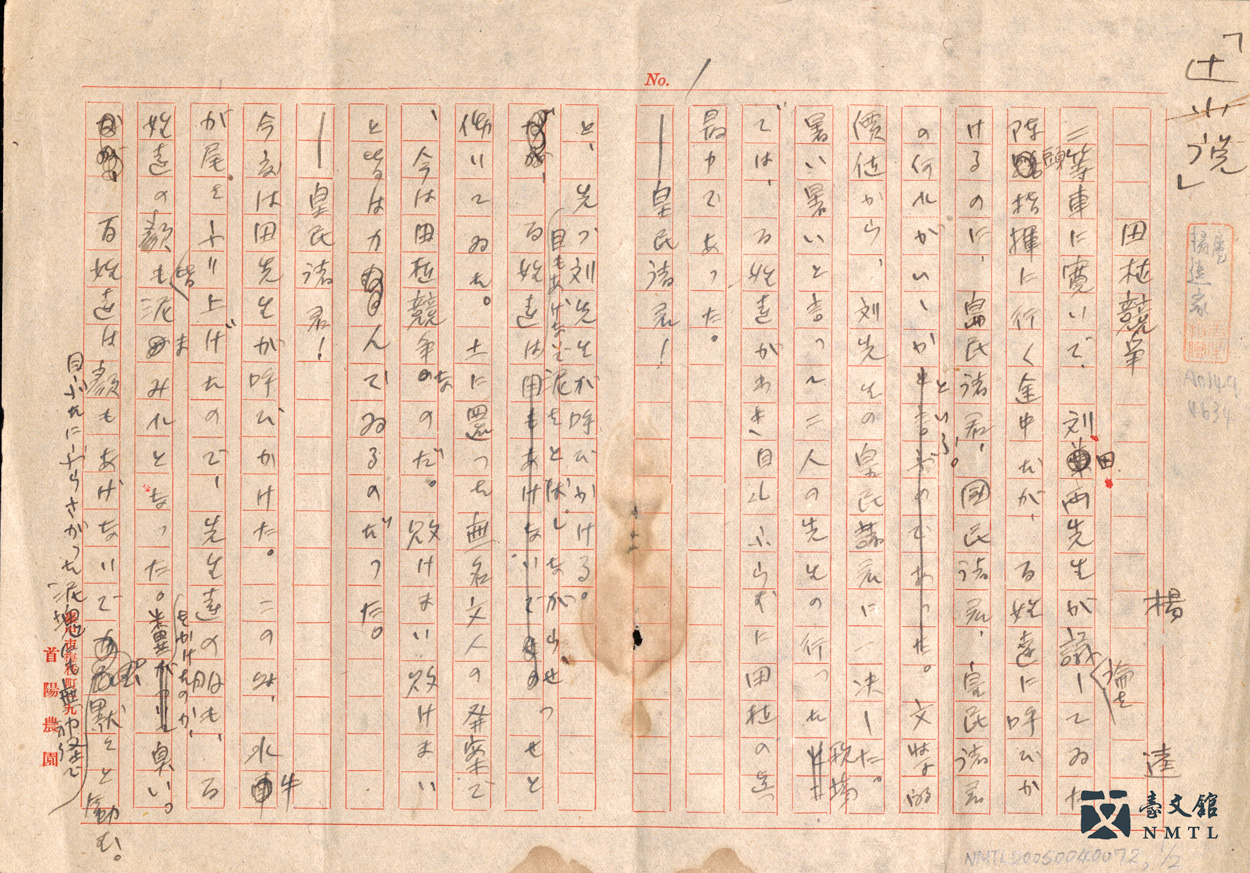
▸ Yang Kuei, Manuscript of "Rice Transplanting Competition"|Unpublished novel by Yang Kuei (1906-1985). The novel illustrates two teachers, Liu and Tien, travelling through rural Taiwan to promote Nipponization (the adoption of Japanese culture, language and other homeland traits). Yet, their clothes are tarnished by feces. Through this novel, Yang attempted to respond to the debate over "fecal realism" initiated by Mitsuru Nishikawa.
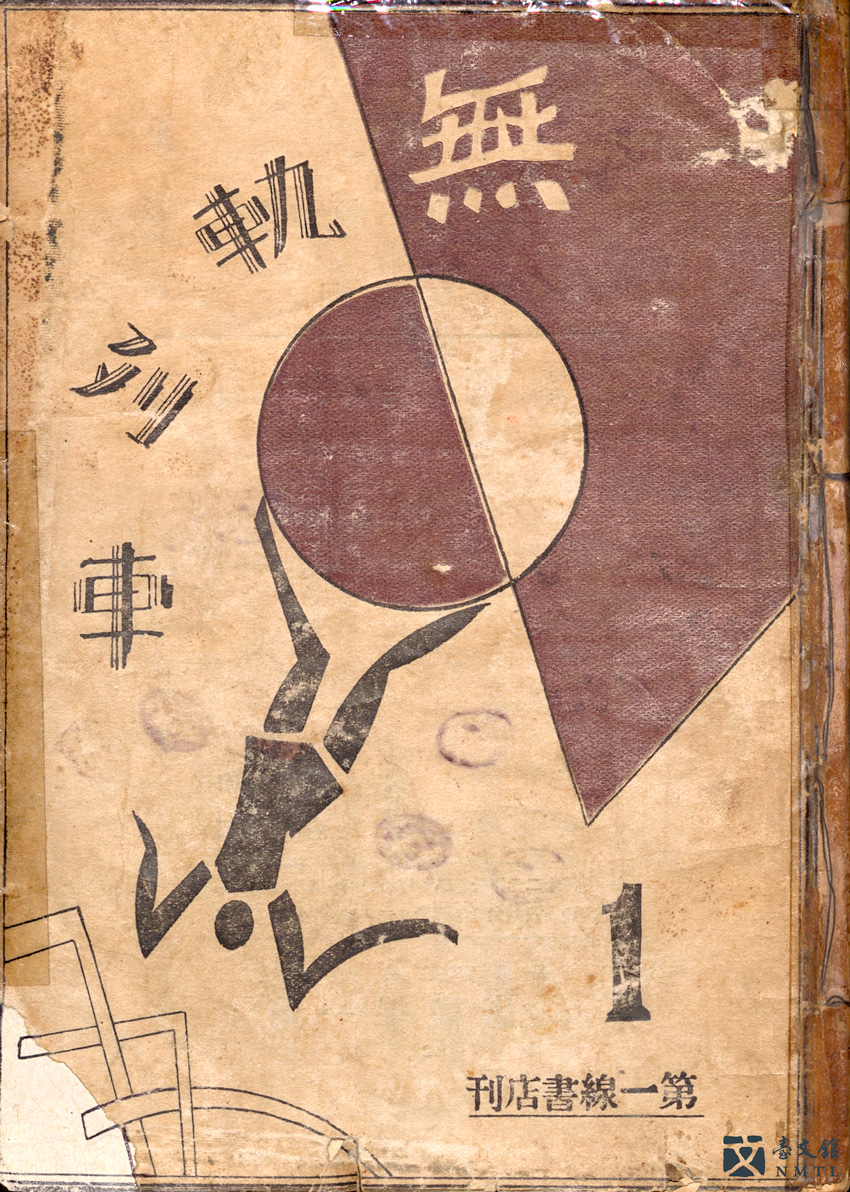
▸ Cover of the First Book in the TRACKLESS TRAIN Series|The literary periodical Trackless Train was managed by Liu Na-ou, Dai Wang-shu, and Shi Zhe-cun and published by Shanghai's First Line Publishing House on September 10, 1928. There were 8 issues in total, and the cover was designed by Liu Na-ou. Trackless Train is testament to the vigorous activities of Taiwanese writers in Shanghai in the 1920s.
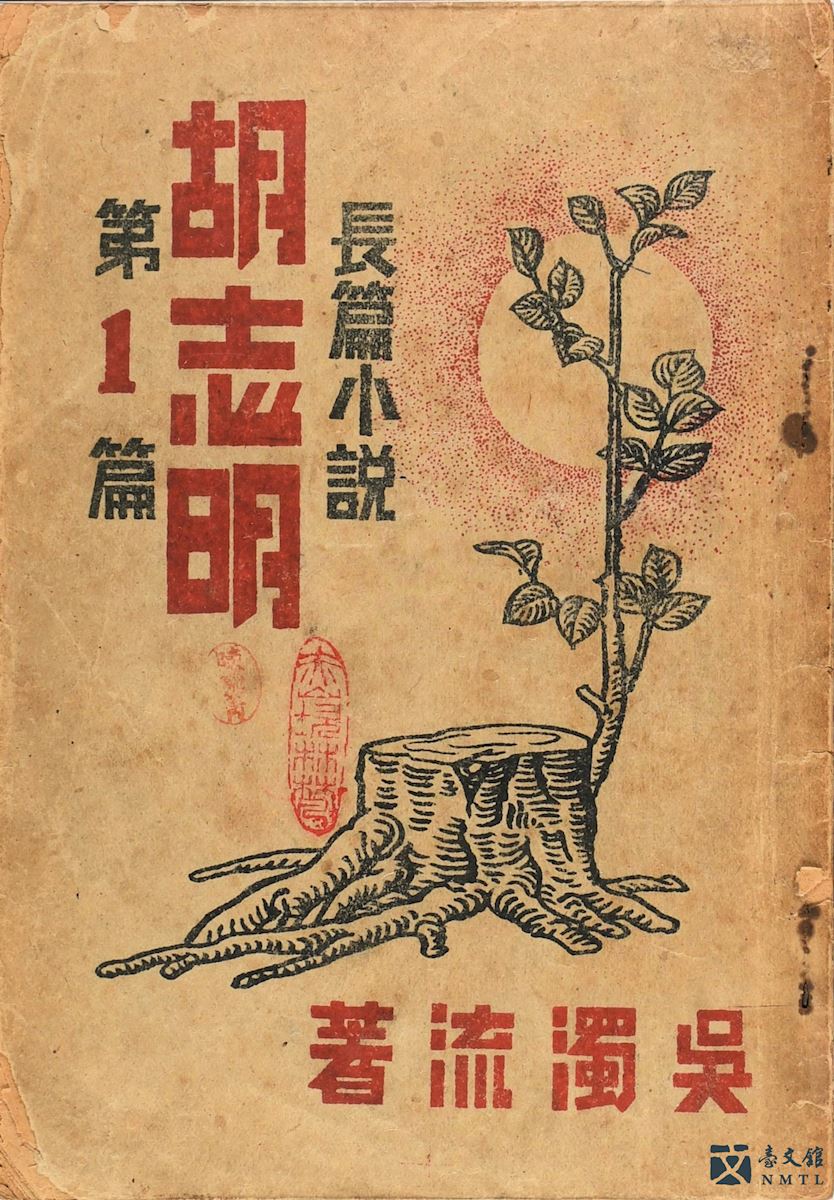
▸ Wu Chuo-liu, Chapter 1, HO CHI MINH|Well-known work by Wu Chuo-liu (1900-1976). Before being renamed as The Orphans of Asia, its original name was Ho Chi Minh. The work illustrates Taiwanese people's struggles and confusion in seeking their self-identity during the Japanese Colonial Period. Written in Japanese, the book was published after the war in 1946 and translated into Chinese later.
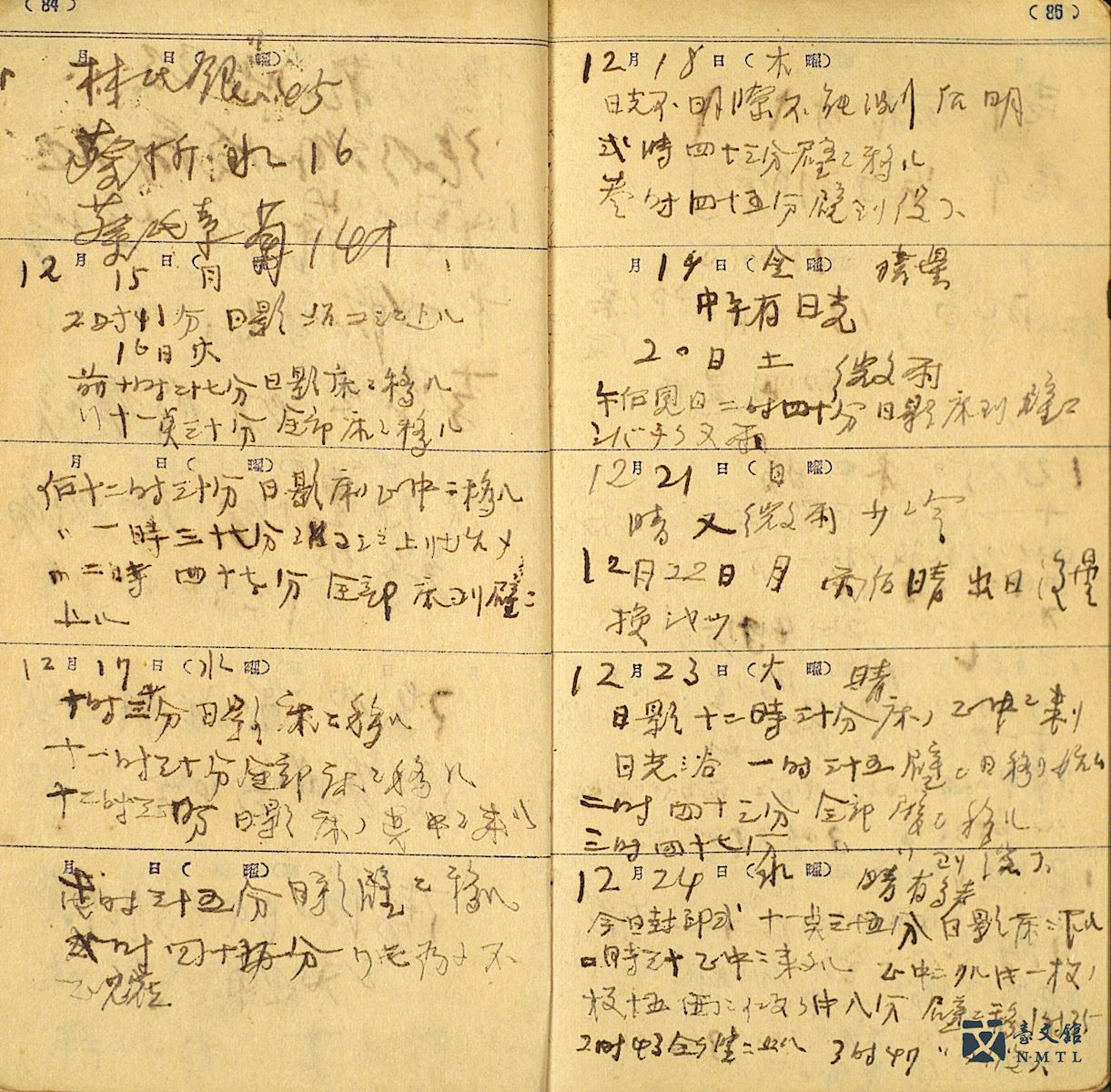
▸ Lai Ho, Manuscript of DIARY IN PRISON|Lai Ho's second imprisonment lasted around 50 days. The notes written on the notebook and rough paper cover around 39 days of his time in jail. The entries were written between December 8, 1941 and January 15, 1942. The second time Lai Ho was sent to prison, he was in very poor physical condition. In the diary, he wrote down his worries about trivial things at home and general affairs in society. There are also a few poems.
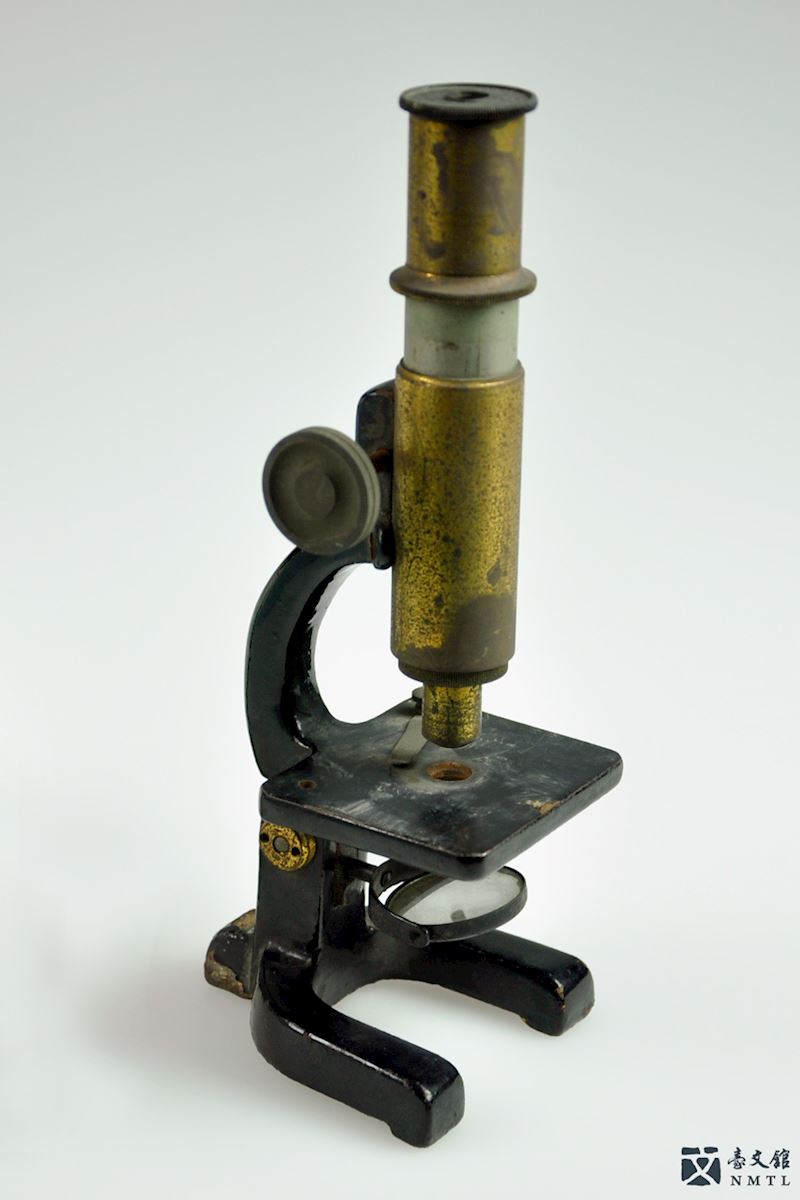
▸ Microscope used by Dr. Chan Tso-chou|A medical assistant's tool used by Chan Tso-chou, a doctor from Changhua. Born in Changhua, Chan Tso-chou (1897-1980) was a classmate of Tu Tsung-ming, Taiwan's first Doctor of Medical Science, and Lai Ho, the 'father' of modern Taiwan literature. After graduation, Chan interned at Taichung Hospital for three years and then opened Shengchun Hospital on Yongjing Street.
\(´◓Д◔`)/ Songs under the Sirens: Literature in Wartime
With the outbreak of the Second Sino-Japanese War in 1937 and Japan's subsequent expansion across East Asia, the colonial authorities launched strict new policies to keep their Taiwanese subjects loyal to the Japanese Empire. Chinese was no longer taught in schools, most Chinese-language publications were shut down, and Hokkien words and phrases could no longer be used in literature. A new generation of writers, including Yang Kuei, Zhang Wen-huan, Lu He-ruo, Long Ying-zong, and Ang Lāu, all of who had experienced world literature in Japanese, continued giving Taiwan a voice during this period, albeit in a language approved by its colonial masters. Taiwanese authors directly challenged the Empire's mainstream literary discourse in numerous works that were published and subsequently honored in Tokyo with prestigious awards, revealing the resolute tenacity of Taiwan's authors in wartime.
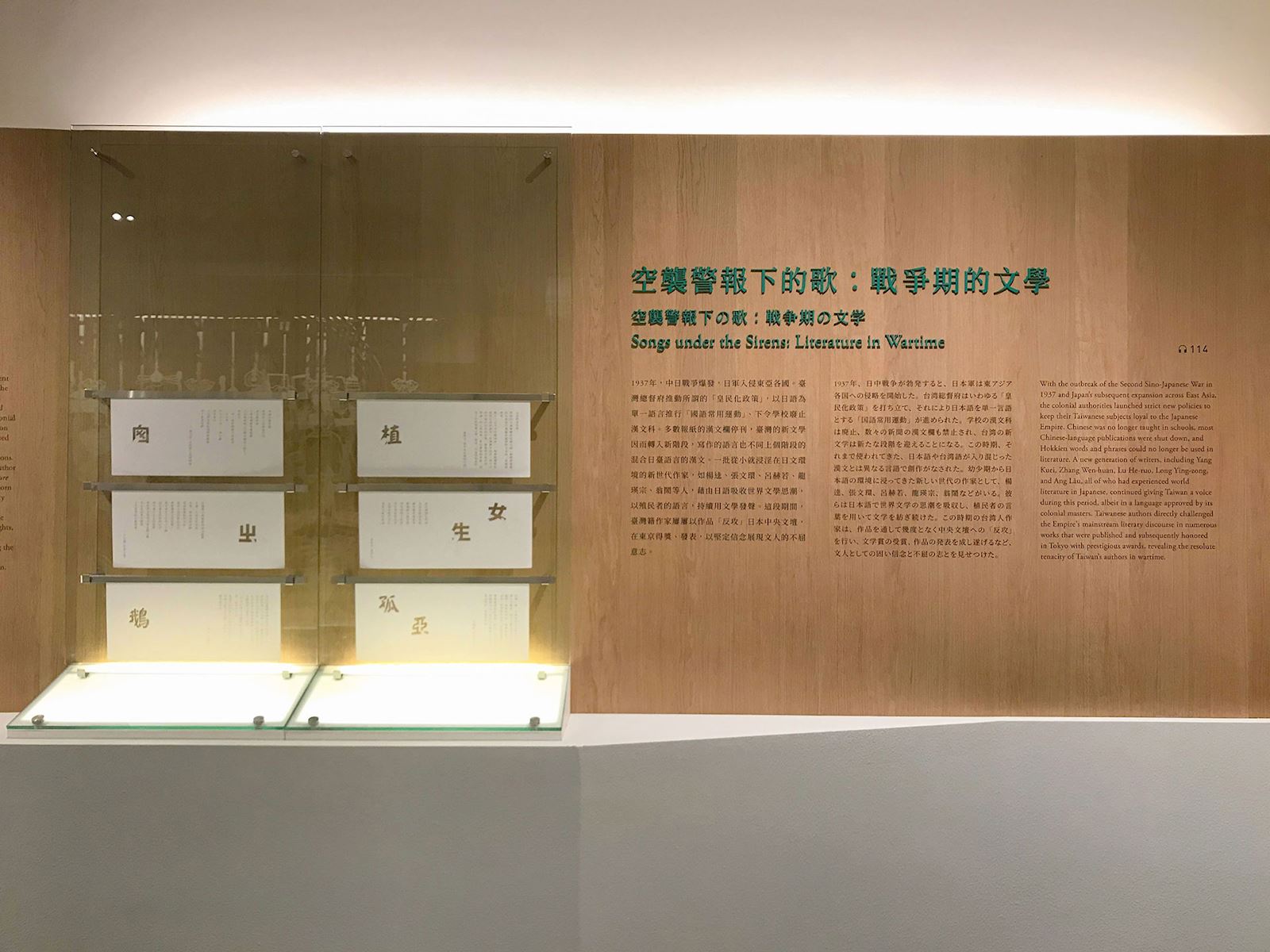
As the Pacific War intensified, the Japanese government redirected all of the nation's available resources into the war effort. Taiwanese writers could now be drafted as press writers and propagandists. The Council of Loyal Taiwan Authors was established in 1943, and the colonial government, in addition to enforcing stricter controls on speech and severe penalties for 'seditious' writings, forced authors to issue loyalty statements and write pro-war works. Taiwan's literary community split into two factions. Supporters of the loyalty cause, led by Japanese-born author Mitsuru Nishikawa, published in TAIWAN ART AND CULTURE (BUNGEI TAIWAN). Those in opposition, led by Taiwan-born author Zhang Wen-huan, worked to subvert the loyalty movement via works published in TAIWAN LITERATURE (TAIWAN BUNGAKU). In this 'pressure cooker', Taiwanese authors took the New Literature movement to new heights, deftly describing psychological struggles over identity, plumbing the dark side of human nature, and exploring the subtleties of the human character. Literary gems were wrought in the intolerable pressures of wartime Taiwan.
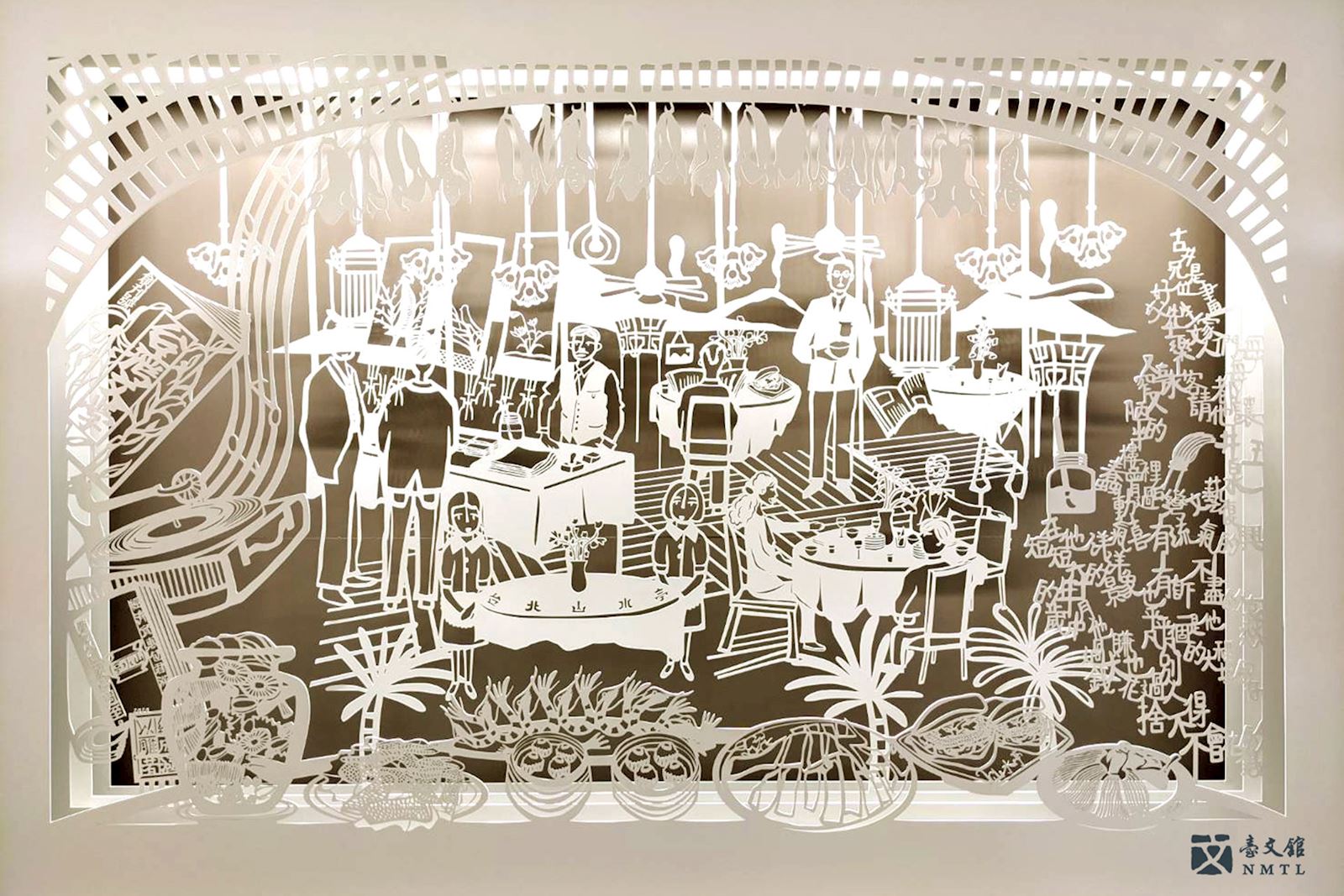
THREE PEOPLE TOGETHER Shanshui Pavilion Art Installation (Cheng-Jo-Han|2020 |coated metal)
“In an era of chaos, there was Shanshui Pavilion in Twatutia (Dadaocheng), Taipei. Standing along the streets filled with big restaurants, Shanshui Pavilion serves all types of dishes. Apart from whole roasted duck, golden shrimp, and braised shark fin soup, its pork belly buns, chicken claw jelly, and shumai are must-eat dishes for poets and painters. With rice perfectly matching all sorts of flavors, Mr. Nice is the humblest sidekick.”
This work illustrates stories of Shanshui Pavilion. “叄(three)” incorporates “山 (mountain)” and “川 (river)” and symbolizes the Confucian idea that “when three are walking together, I am sure to find teachers among them.”
In addition, through the surreal transformation of the Taiwanese restaurant Shanshui Pavilion and inspiration from the visual effects of shadow play performance theater, moving shadows recreate the scene of writers' enthusiastic literary discussions and manifest the unbending spirit of the new-generation of writers during the Japanese Colonial Period. (Note: Shanshui Pavilion attracted many writers based in Taipei, such as Lu He-ruo, Lin Mo-sei, Zhang Wen-huan and Huang Deshi as well as Japanese young people who disagreed with Japan's supremacism, including Kanaseki Takeo and Toshio Ikeda)
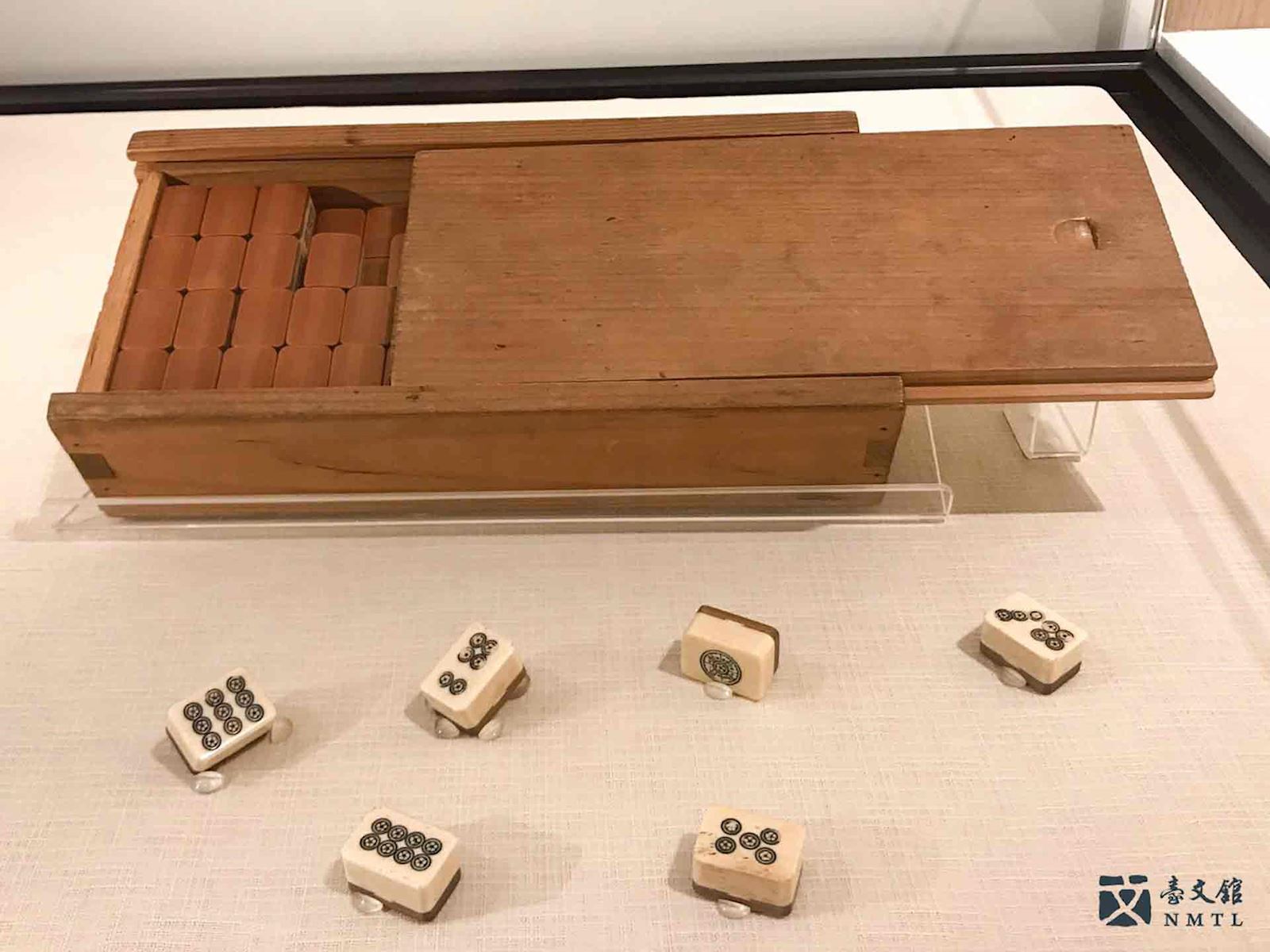
▸ Mahjong used by Liu Na-ou|When Liu Na-ou (1905-1940) lived in Shanghai in the 1920s and 1930s, he was a part of the "Shinkankakuha" literary group along with Shi Zhe-cun and Dai Wang-shu. In addition to literature, Liu liked to play mahjong and to dance – both popular entertainment activities in Shanghai back then.
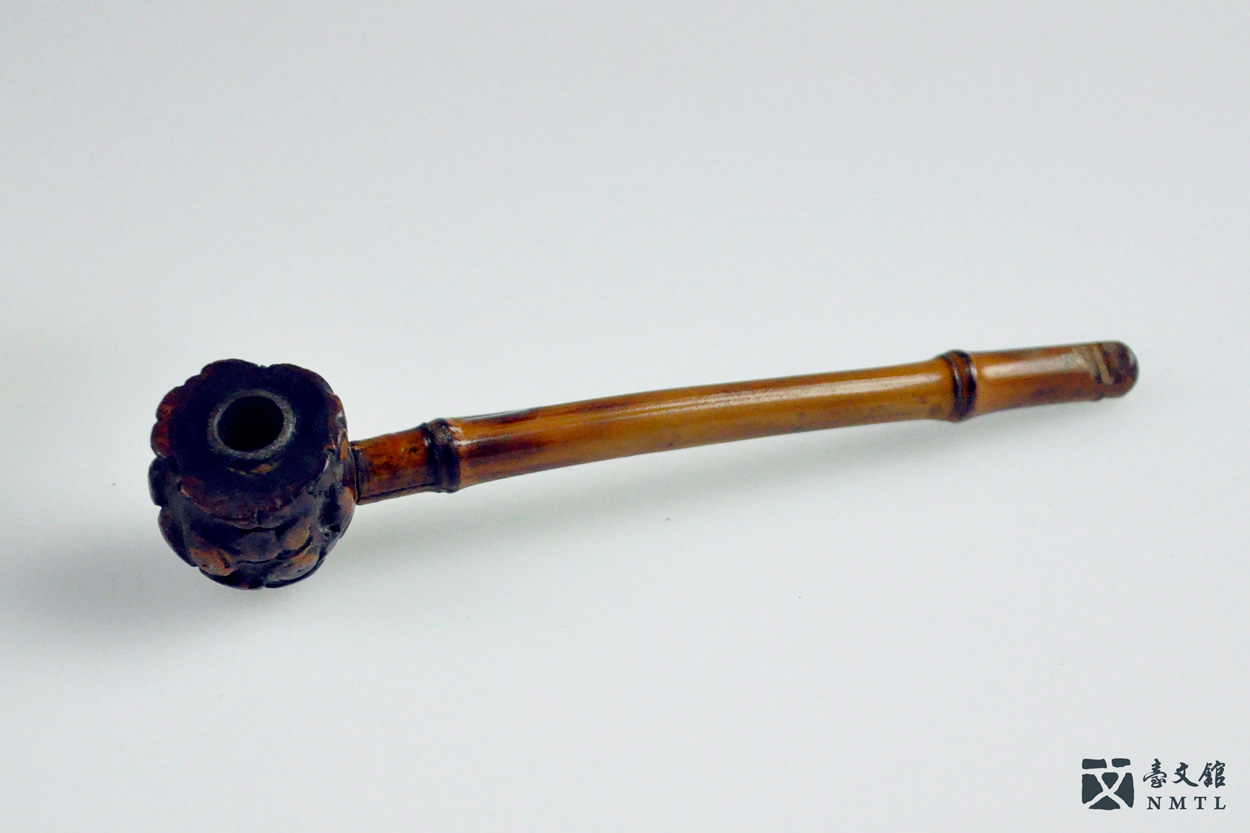
▸ Tobacco pipe owned by Wang Kai-yun|Specially-shaped tobacco pipe owned by Wang Kai-yun (1889-1969), a poet from Tainan. Wang always brought his tobacco pipe and ink with him. He gave numerous tobacco pipes to his literary friends and saved only a few for himself. This tobacco pipe is a reflection of his life.
ƪ(˘⌣˘)ʃ Authors as Household Names: Urbanization and Popular Literature
The entertainment industry grew in importance with Taiwan's urbanization, giving birth to a new phenomenon - popular authors. Popular authors are a benchmark of social modernization that signal widespread literacy and the existence of mature markets for publishing and mass media. Taiwan's first generation of popular authors, including Xu Kun-quan, Xu Bing-ding, and Zheng Kun-wu, delved into science fiction, mystery, the paranormal, martial heroics, and romance - genres that would be mainstreamed during the latter half of the 20th century. Unlike the authors of 'new literature', popular authors freely interwove modern and classical elements in their works, creating an alluring experience for readers that was simultaneously fresh and familiar.
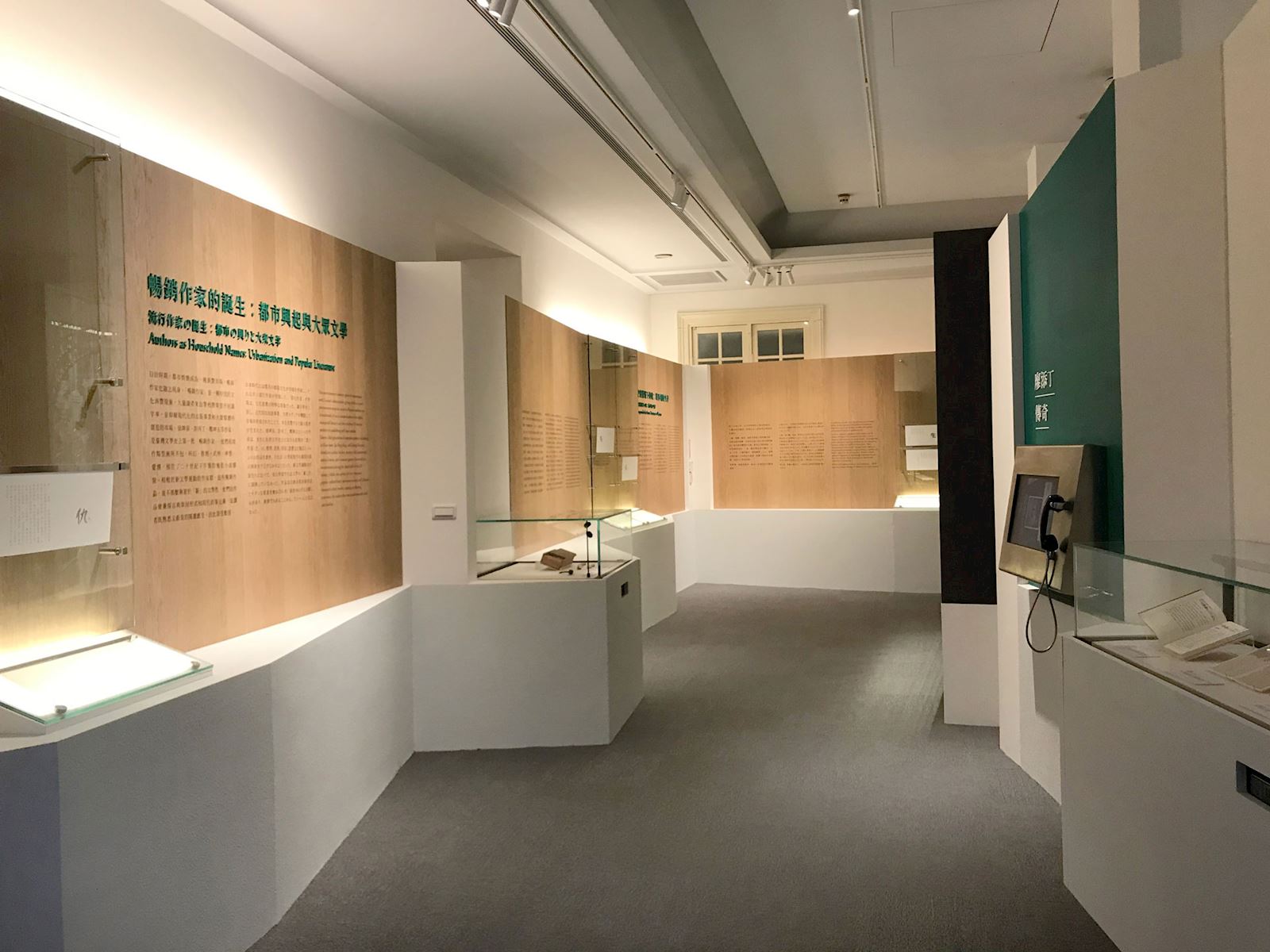
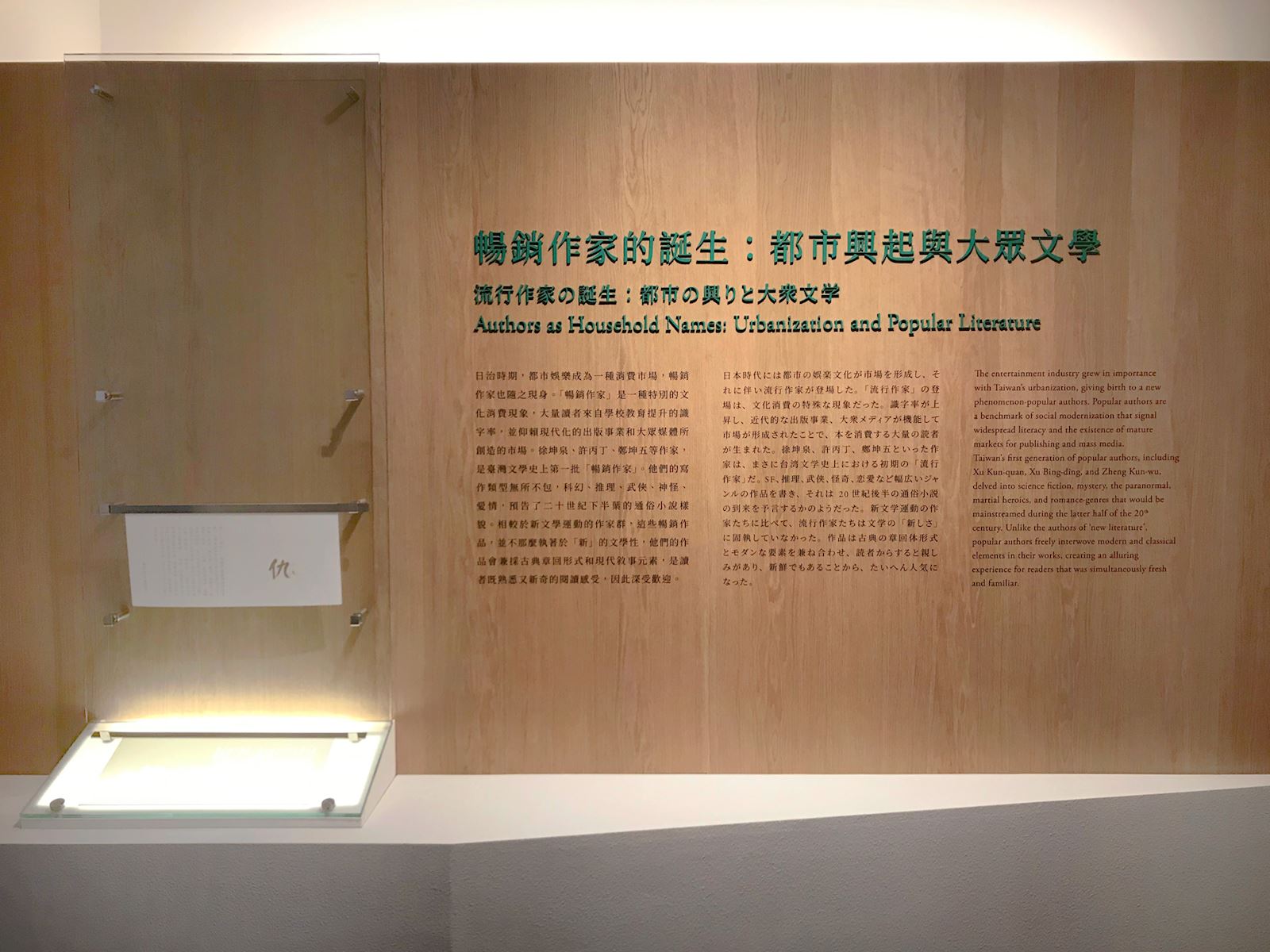
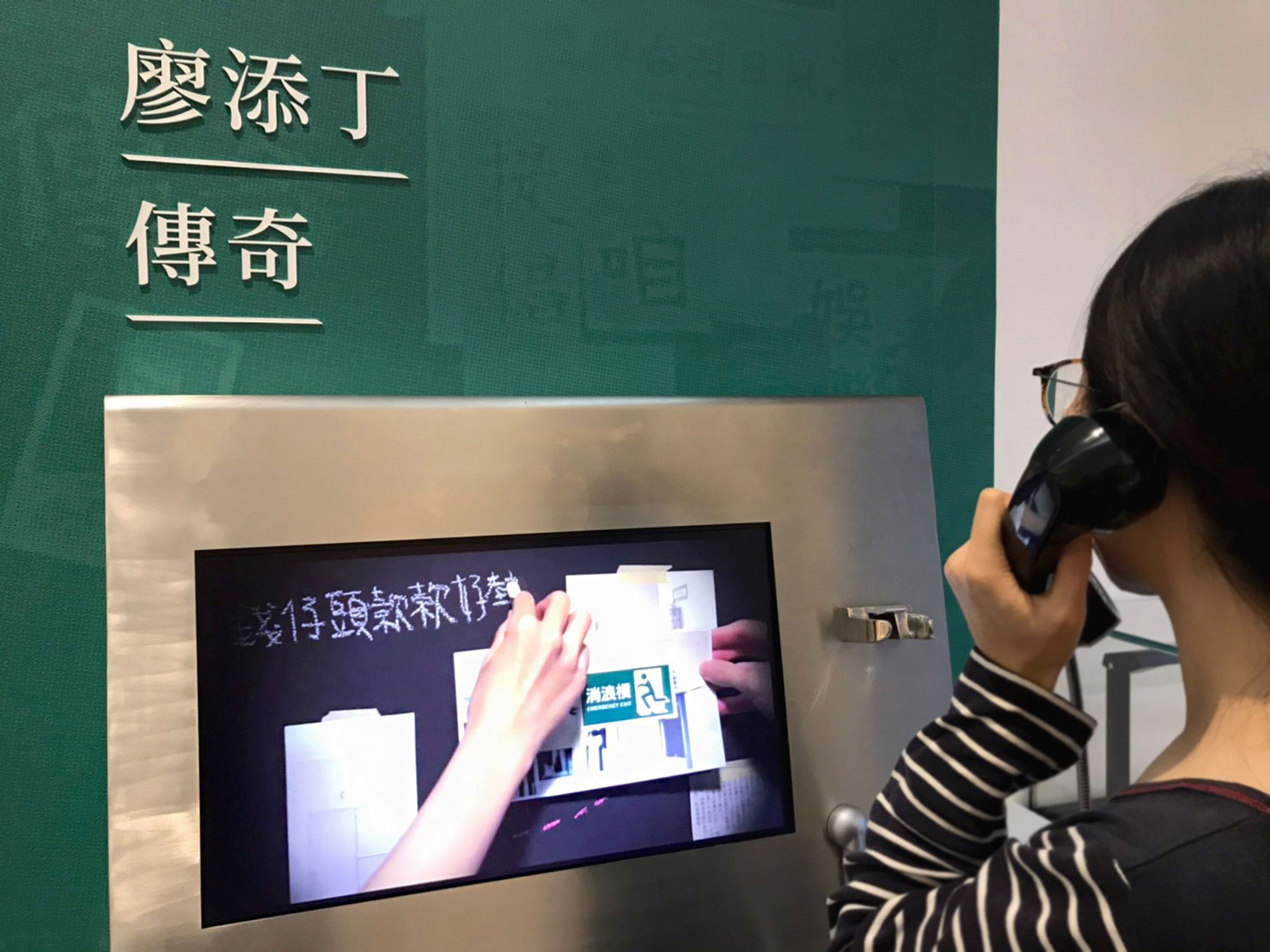
LEGEND OF LIAO TIAN-DING Multimedia Installation
This video presents Taiwan's traditional oral performing arts based on the folk legend—Liao Tian-ding. Recorded with a fast tempo, the video creates an interesting and lively atmosphere. Pick up the receiver and listen to the fragments performed by the national treasure artist— Yang Xiu-qing.
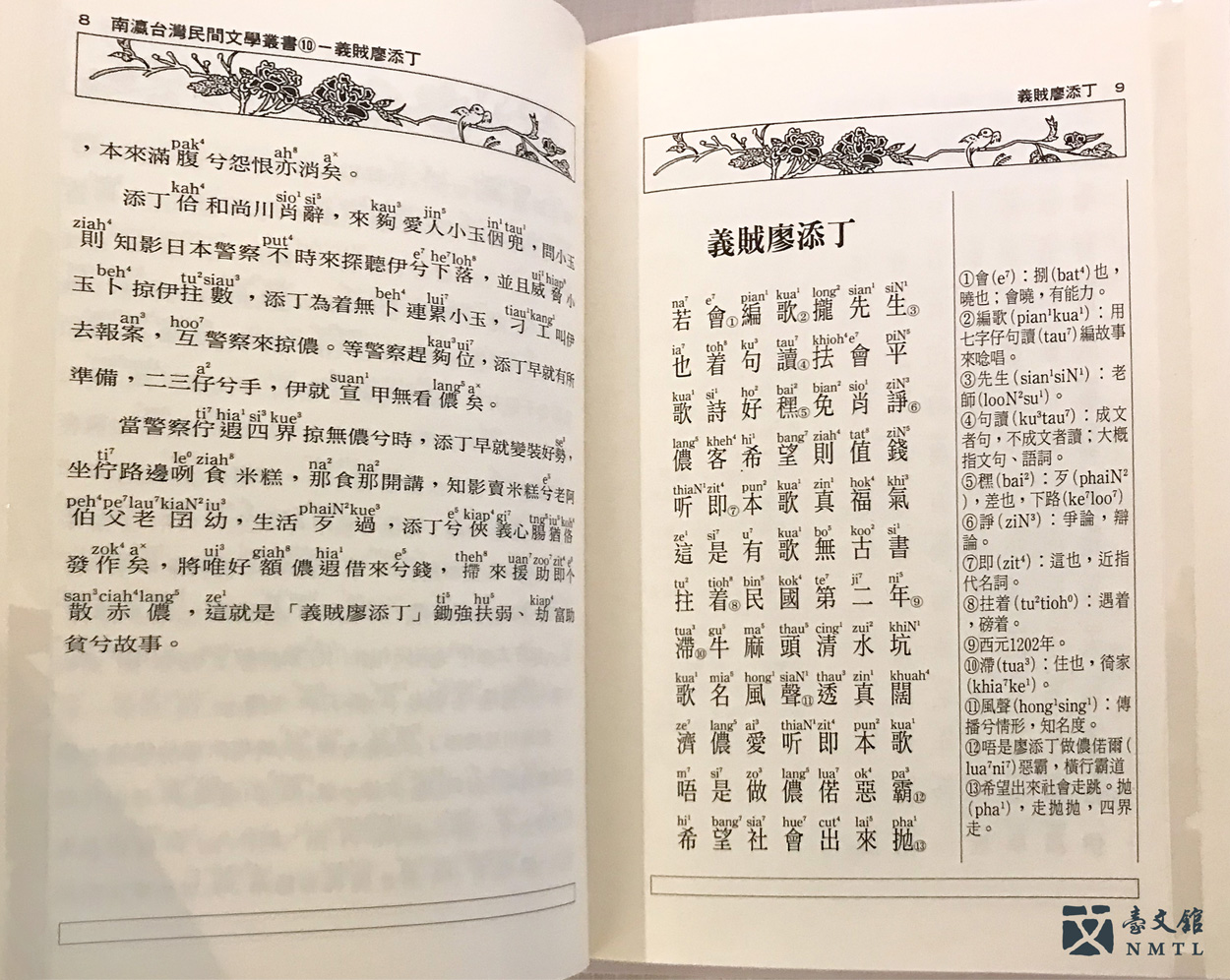
▸ Liang Song-lin, GENTLEMAN THIEF LIAO TIAN-DING|Liang Song-lin's version of this story was published in May 1955 by Taipei Yicheng Publishing House. The story of Liao Tian-ding, who committed thefts during the Japanese Colonial Period, was based on a real person and his deeds. However, in the folk legend, he became a "gentleman thief" who was active in the era when Japanese people and capitalists harshly treated the impoverished commoners. His "gentleman" deeds were later transformed into a legend filled with national identify and anti-capitalist sentiment.
-1.jpg)
▸ Xu Bing-ding, HSIAO FÊNG SHÊN (小封神) (No. 99, 369 News)|Written by Xu Bing-ding (1899-1977), HSIAO FÊNG SHÊN (小封神) is a mythological novel centering on Tainan. It combines stories about Taiwan's local religious beliefs and historical events. Written completely in Taiwanese, the book is humorous and interesting. In 1931, this story began to appear in installments on 369 News. After the war, a Chinese version was released.
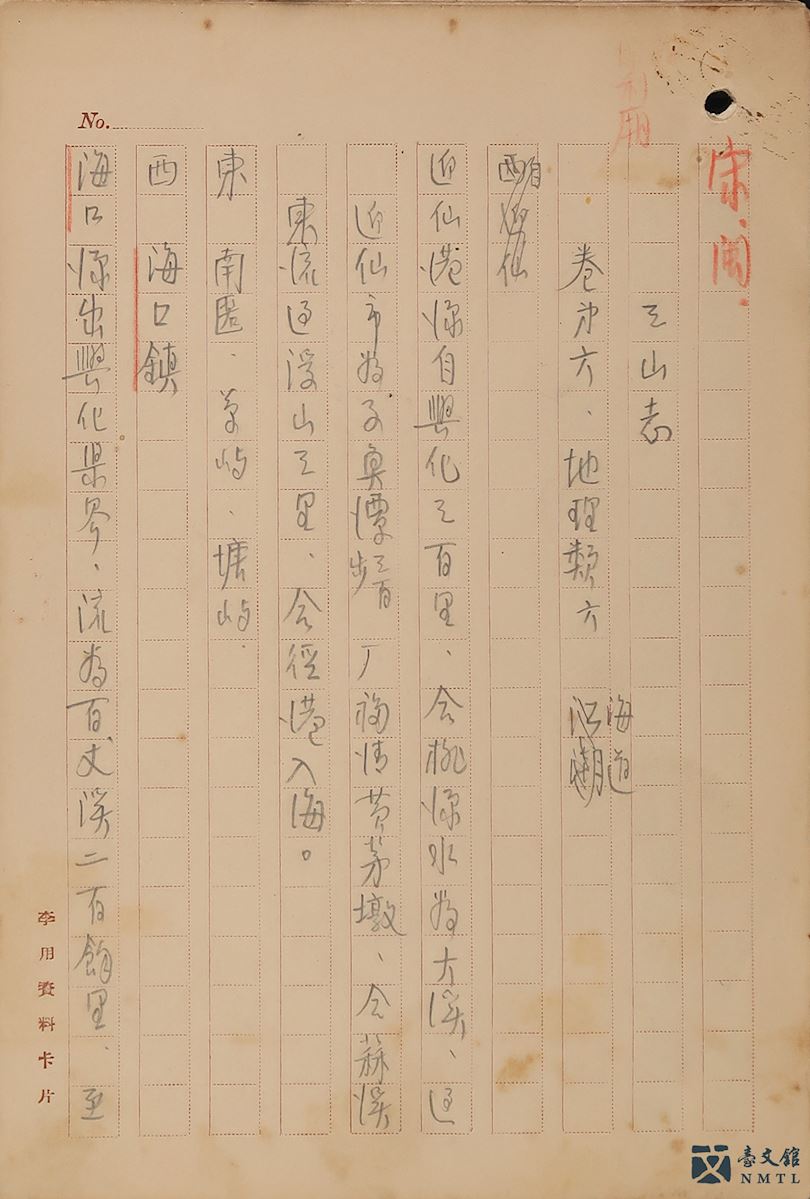

▸ Li Xian-zhang, Manuscript of “Mazu Relations”|A study on the Mazu belief by Li Xian-zhang, a folk culture and literature researcher. His work covering the "contemporary Nagasaki" period contains myriad collected materials and was compiled into a book called Study on Mazu.
〉.jpg)
▸ Li Yi-tao, Wonders in the Indigenous Realm (first half)|Li Yi-tao's long novel published in Chinese Taiwan Daily News (November 3, 1910 to November 14, 1910). This is a literary work about the indigenous peoples. The Han main characters are all cultured and good-looking, whereas the indigenous male characters are unseemly and ugly. The indigenous world created by Li is an abhorrent realm that is contrasted with the Han world, which is focused on assimilating the indigenous peoples.
